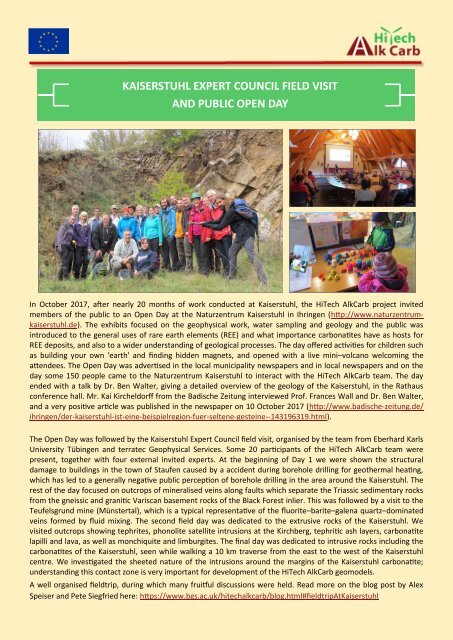Newsletter Spring2018_A4single_final
You also want an ePaper? Increase the reach of your titles
YUMPU automatically turns print PDFs into web optimized ePapers that Google loves.
KAISERSTUHL EXPERT COUNCIL FIELD VISIT<br />
AND PUBLIC OPEN DAY<br />
In October 2017, after nearly 20 months of work conducted at Kaiserstuhl, the HiTech AlkCarb project invited<br />
members of the public to an Open Day at the Naturzentrum Kaiserstuhl in Ihringen (http://www.naturzentrumkaiserstuhl.de).<br />
The exhibits focused on the geophysical work, water sampling and geology and the public was<br />
introduced to the general uses of rare earth elements (REE) and what importance carbonatites have as hosts for<br />
REE deposits, and also to a wider understanding of geological processes. The day offered activities for children such<br />
as building your own 'earth' and finding hidden magnets, and opened with a live mini–volcano welcoming the<br />
attendees. The Open Day was advertised in the local municipality newspapers and in local newspapers and on the<br />
day some 150 people came to the Naturzentrum Kaiserstuhl to interact with the HiTech AlkCarb team. The day<br />
ended with a talk by Dr. Ben Walter, giving a detailed overview of the geology of the Kaiserstuhl, in the Rathaus<br />
conference hall. Mr. Kai Kircheldorff from the Badische Zeitung interviewed Prof. Frances Wall and Dr. Ben Walter,<br />
and a very positive article was published in the newspaper on 10 October 2017 (http://www.badische-zeitung.de/<br />
ihringen/der-kaiserstuhl-ist-eine-beispielregion-fuer-seltene-gesteine--143196319.html).<br />
The Open Day was followed by the Kaiserstuhl Expert Council field visit, organised by the team from Eberhard Karls<br />
University Tübingen and terratec Geophysical Services. Some 20 participants of the HiTech AlkCarb team were<br />
present, together with four external invited experts. At the beginning of Day 1 we were shown the structural<br />
damage to buildings in the town of Staufen caused by a accident during borehole drilling for geothermal heating,<br />
which has led to a generally negative public perception of borehole drilling in the area around the Kaiserstuhl. The<br />
rest of the day focused on outcrops of mineralised veins along faults which separate the Triassic sedimentary rocks<br />
from the gneissic and granitic Variscan basement rocks of the Black Forest inlier. This was followed by a visit to the<br />
Teufelsgrund mine (Münstertal), which is a typical representative of the fluorite–barite–galena quartz–dominated<br />
veins formed by fluid mixing. The second field day was dedicated to the extrusive rocks of the Kaiserstuhl. We<br />
visited outcrops showing tephrites, phonolite satellite intrusions at the Kirchberg, tephritic ash layers, carbonatite<br />
lapilli and lava, as well as monchiquite and limburgites. The <strong>final</strong> day was dedicated to intrusive rocks including the<br />
carbonatites of the Kaiserstuhl, seen while walking a 10 km traverse from the east to the west of the Kaiserstuhl<br />
centre. We investigated the sheeted nature of the intrusions around the margins of the Kaiserstuhl carbonatite;<br />
understanding this contact zone is very important for development of the HiTech AlkCarb geomodels.<br />
A well organised fieldtrip, during which many fruitful discussions were held. Read more on the blog post by Alex<br />
Speiser and Pete Siegfried here: https://www.bgs.ac.uk/hitechalkcarb/blog.html#fieldtripAtKaiserstuhl


